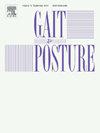Can gait analysis identify relapse in children with congenital talipes equinovarus? A systematic review & meta-analysis
IF 2.2
3区 医学
Q3 NEUROSCIENCES
引用次数: 0
Abstract
Background
Congenital talipes equinovarus (CTEV) is a common congenital condition. Following initial treatment patients can relapse, requiring further intervention. Gait analysis evaluates kinematics throughout gait, which have been demonstrated to differ between CTEV children and typically developing children. However, it is unclear whether there is a difference in kinematic parameters between those with CTEV who relapse and those who do not. We therefore aimed to synthesise current evidence to answer this question and to determine whether gait analysis could play a role in relapse monitoring.
Methods
Systematic review of the literature was conducted according to PRISMA guidelines. MEDLINE, Embase, CINAHL, Emcare and Cochrane databases were searched to identify studies comparing gait analysis in children < 18 years with CTEV with and without relapse. End points included Gait Deviation Index (GDI) score and individual kinematic parameters. Random-effects meta-analysis was performed using Stata 17.0 BE to calculate pooled mean-difference in GDI score, walking-velocity and stride-length between groups.
Results
Six studies were included (264 participants, 301 feet). Reduced dorsiflexion and increased forefoot adduction and supination were detected by gait analysis in relapse. Lower GDI scores were observed in relapse compared to non-relapse (pooled mean-difference 5.23,95 % CI 2.33–8.13,p < 0.001). No overall difference was detected in walking-velocity (pooled mean-difference 0.05 m/s,95 % CI 0–0.11,p = 0.06) or stride-length (pooled mean-difference 0.04 m,95 % CI 0.02–0.1,p = 0.18).
Conclusions
Differences in GDI score and individual kinematic parameters, particularly of the forefoot, are detected between relapse and non-relapse through gait analysis, suggesting gait analysis may have a potential role to aid detection of relapse.
Level of evidence
Level IV
步态分析能识别先天性马蹄内翻患儿的复发吗?系统回顾和荟萃分析
背景先天性马蹄内翻(CTEV)是一种常见的先天性疾病。初始治疗后,患者可能复发,需要进一步干预。步态分析评估整个步态的运动学,已证明CTEV儿童与典型发育儿童之间存在差异。然而,尚不清楚复发的CTEV患者和未复发的CTEV患者的运动学参数是否存在差异。因此,我们旨在综合目前的证据来回答这个问题,并确定步态分析是否可以在复发监测中发挥作用。方法按照PRISMA指南对相关文献进行系统综述。检索MEDLINE、Embase、CINAHL、Emcare和Cochrane数据库,以确定比较18岁CTEV患儿( )有无复发的步态分析的研究。终点包括步态偏离指数(GDI)评分和个体运动学参数。采用Stata 17.0 BE进行随机效应meta分析,计算两组间GDI评分、步行速度和步幅的合并平均差异。结果共纳入6项研究(264名参与者,301英尺)。复发时通过步态分析发现背屈减少,前足内收和旋后增加。与未复发患者相比,复发患者GDI评分较低(合并平均差为5.23,95 % CI 2.33-8.13,p <; 0.001)。行走速度(合并平均差值0.05 m/s,95 % CI 0-0.11,p = 0.06)或步幅(合并平均差值0.04 m,95 % CI 0.02-0.1,p = 0.18)未发现总体差异。结论通过步态分析可以检测到复发和非复发患者GDI评分和个体运动学参数的差异,特别是前足,表明步态分析可能有助于检测复发。证据等级:四级
本文章由计算机程序翻译,如有差异,请以英文原文为准。
求助全文
约1分钟内获得全文
求助全文
来源期刊

Gait & posture
医学-神经科学
CiteScore
4.70
自引率
12.50%
发文量
616
审稿时长
6 months
期刊介绍:
Gait & Posture is a vehicle for the publication of up-to-date basic and clinical research on all aspects of locomotion and balance.
The topics covered include: Techniques for the measurement of gait and posture, and the standardization of results presentation; Studies of normal and pathological gait; Treatment of gait and postural abnormalities; Biomechanical and theoretical approaches to gait and posture; Mathematical models of joint and muscle mechanics; Neurological and musculoskeletal function in gait and posture; The evolution of upright posture and bipedal locomotion; Adaptations of carrying loads, walking on uneven surfaces, climbing stairs etc; spinal biomechanics only if they are directly related to gait and/or posture and are of general interest to our readers; The effect of aging and development on gait and posture; Psychological and cultural aspects of gait; Patient education.
 求助内容:
求助内容: 应助结果提醒方式:
应助结果提醒方式:


